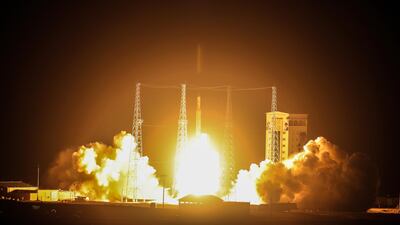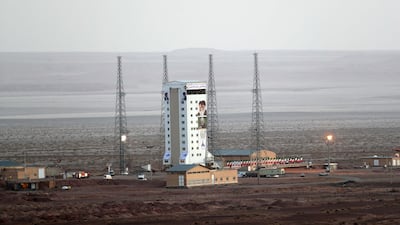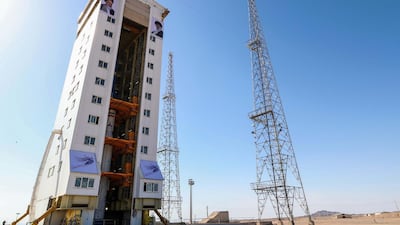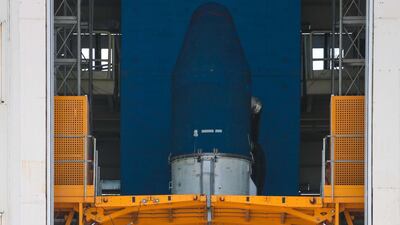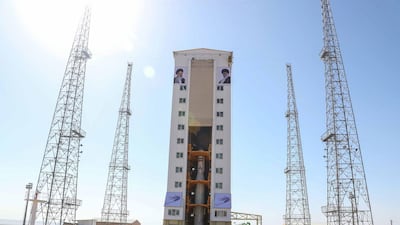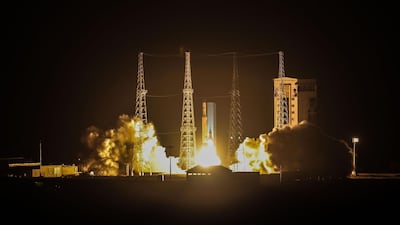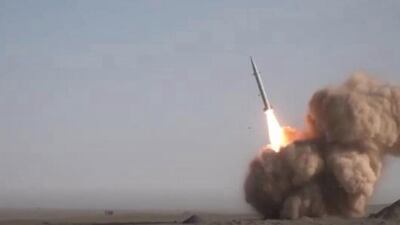Iran’s satellite launchers could be “easily modified” into ballistic missiles following the first successful mission of a military orbiter, an international think tank has warned.
The chief of the Islamic Revolutionary Guard Corps has also claimed that the first launch of a military satellite takes the country’s spying capabilities to the "next level".
His words come as the IRGC seeks use the success to boost its influence in Iran’s internal power struggle after the government suffered criticism for its handling of the coronavirus crisis.
A reconfigured Satellite Launch Vehicle (SLV), using solid-fuel motors of a Sejil medium range missile, could send a rocket armed with a 1,000kg payload for a distance of 2,500km, according to a report by the International Institute of Strategic Studies. The range would bring much of central Europe within range as well as large parts of China and all India.
Solid fuel motors also posed much more of a threat, the report warned. “Herein lies an emerging concern about the IRGC’s nascent space programme. Solid-fuel motors are more compact than their liquid-fuel counterparts. They are also simpler to deploy, transport and launch.”
The solid-fuel systems were not only the military’s preferred choice for ballistic missiles but also demonstrated that the launch vehicles could be “more easily modified for use as a ballistic missile”.
Although no other military has yet turned a liquid-fuel SLV into a ballistic rocket, both Israel and India have converted solid-fuel launchers into missiles.
“Iran could do the same over the next five to ten years if the IRGC space programme continues unabated,” said the report author Mike Elleman, IISS Director of Non-Proliferation and Nuclear Policy Programme.
To prevent Iran developing an intercontinental range missile which would bring America within range, a deal is urgently needed to be negotiated for satellite launches.
"To reduce the risk of the Islamic Republic from developing an intercontinental-range missile capability under the guise of space-launch activities, the international community must negotiate a compromise that permits Iran to launch satellites for peaceful purposes, but prohibits the use of solid-fuel motors larger than the Sejil's first stage," the report stated.
The successful mission marked the first time Iran’s military has carried out a satellite launch. All previous attempts were made by the civilian space arm, the Iranian Space Agency, which suffered a series of mishaps. The military satellite is currently orbiting 440km above the Earth.
Following the April 22 launch, the Guard’s commander-in-chief, Major General Hossein Salami, said it was “a strategic achievement” that took Iran’s defence and information gathering capabilities to the next level.
The officer, who regularly targets America, Israel and Saudi Arabia in aggressive speeches, said it was a new step in Iran’s quest to enhance its regional and global power.
The IISS confirmed the launch was a “powerful message of defiance” to the US and Gulf States particularly at a time when Iran was apparently suffering from very low oil prices and the assassination of the Quds Force leader Qassem Suleimani in January.
Sarfira
Director: Sudha Kongara Prasad
Starring: Akshay Kumar, Radhika Madan, Paresh Rawal
Rating: 2/5
About Okadoc
Date started: Okadoc, 2018
Founder/CEO: Fodhil Benturquia
Based: Dubai, UAE
Sector: Healthcare
Size: (employees/revenue) 40 staff; undisclosed revenues recording “double-digit” monthly growth
Funding stage: Series B fundraising round to conclude in February
Investors: Undisclosed
Company%20profile
%3Cp%3E%3Cstrong%3EName%3A%3C%2Fstrong%3E%20JustClean%3Cbr%3E%3Cbr%3E%3Cstrong%3EBased%3A%20%3C%2Fstrong%3EDubai%20with%20offices%20in%20other%20GCC%20countries%3Cbr%3E%3Cbr%3E%3Cstrong%3ELaunch%20year%3A%3C%2Fstrong%3E%202016%3Cbr%3E%3Cbr%3E%3Cstrong%3ENumber%20of%20employees%3A%3C%2Fstrong%3E%20160%2B%20with%2021%20nationalities%20in%20eight%20cities%3Cbr%3E%3Cstrong%3E%3Cbr%3ESector%3A%3C%2Fstrong%3E%20online%20laundry%20and%20cleaning%20services%3Cbr%3E%3Cbr%3E%3Cstrong%3EFunding%3A%20%3C%2Fstrong%3E%2430m%20from%20Kuwait-based%20Faith%20Capital%20Holding%20and%20Gulf%20Investment%20Corporation%3C%2Fp%3E%0A
The stats
Ship name: MSC Bellissima
Ship class: Meraviglia Class
Delivery date: February 27, 2019
Gross tonnage: 171,598 GT
Passenger capacity: 5,686
Crew members: 1,536
Number of cabins: 2,217
Length: 315.3 metres
Maximum speed: 22.7 knots (42kph)
GOLF’S RAHMBO
- 5 wins in 22 months as pro
- Three wins in past 10 starts
- 45 pro starts worldwide: 5 wins, 17 top 5s
- Ranked 551th in world on debut, now No 4 (was No 2 earlier this year)
- 5th player in last 30 years to win 3 European Tour and 2 PGA Tour titles before age 24 (Woods, Garcia, McIlroy, Spieth)
CONFIRMED%20LINE-UP
%3Cp%3EElena%20Rybakina%20(Kazakhstan)%3Cbr%3EOns%20Jabeur%20(Tunisia)%3Cbr%3EMaria%20Sakkari%20(Greece)%3Cbr%3EBarbora%20Krej%C4%8D%C3%ADkov%C3%A1%20(Czech%20Republic)%3Cbr%3EBeatriz%20Haddad%20Maia%20(Brazil)%3Cbr%3EJe%C4%BCena%20Ostapenko%20(Latvia)%3Cbr%3ELiudmila%20Samsonova%3Cbr%3EDaria%20Kasatkina%3Cbr%3EVeronika%20Kudermetova%3Cbr%3ECaroline%20Garcia%20(France)%3Cbr%3EMagda%20Linette%20(Poland)%3Cbr%3ESorana%20C%C3%AErstea%20(Romania)%3Cbr%3EAnastasia%20Potapova%3Cbr%3EAnhelina%20Kalinina%20(Ukraine)%3Cbr%3EJasmine%20Paolini%20(Italy)%3Cbr%3EEmma%20Navarro%20(USA)%3Cbr%3ELesia%20Tsurenko%20(Ukraine)%3Cbr%3EEmma%20Raducanu%20(Great%20Britain)%20%E2%80%93%20wildcard%3C%2Fp%3E%0A
MATCH INFO
Juventus 1 (Dybala 45')
Lazio 3 (Alberto 16', Lulic 73', Cataldi 90 4')
Red card: Rodrigo Bentancur (Juventus)
The specs
Engine: 2.3-litre, turbo four-cylinder
Transmission: 10-speed auto
Power: 300hp
Torque: 420Nm
Price: Dh189,900
On sale: now
Herc's Adventures
Developer: Big Ape Productions
Publisher: LucasArts
Console: PlayStation 1 & 5, Sega Saturn
Rating: 4/5
Trump v Khan
2016: Feud begins after Khan criticised Trump’s proposed Muslim travel ban to US
2017: Trump criticises Khan’s ‘no reason to be alarmed’ response to London Bridge terror attacks
2019: Trump calls Khan a “stone cold loser” before first state visit
2019: Trump tweets about “Khan’s Londonistan”, calling him “a national disgrace”
2022: Khan’s office attributes rise in Islamophobic abuse against the major to hostility stoked during Trump’s presidency
July 2025 During a golfing trip to Scotland, Trump calls Khan “a nasty person”
Sept 2025 Trump blames Khan for London’s “stabbings and the dirt and the filth”.
Dec 2025 Trump suggests migrants got Khan elected, calls him a “horrible, vicious, disgusting mayor”
The President's Cake
Director: Hasan Hadi
Starring: Baneen Ahmad Nayyef, Waheed Thabet Khreibat, Sajad Mohamad Qasem
Rating: 4/5
Red flags
- Promises of high, fixed or 'guaranteed' returns.
- Unregulated structured products or complex investments often used to bypass traditional safeguards.
- Lack of clear information, vague language, no access to audited financials.
- Overseas companies targeting investors in other jurisdictions - this can make legal recovery difficult.
- Hard-selling tactics - creating urgency, offering 'exclusive' deals.
Courtesy: Carol Glynn, founder of Conscious Finance Coaching
A general guide to how active you are:
Less than 5,000 steps - sedentary
5,000 - 9,999 steps - lightly active
10,000 - 12,500 steps - active
12,500 - highly active
The Perfect Couple
Starring: Nicole Kidman, Liev Schreiber, Jack Reynor
Creator: Jenna Lamia
Rating: 3/5
How does ToTok work?
The calling app is available to download on Google Play and Apple App Store
To successfully install ToTok, users are asked to enter their phone number and then create a nickname.
The app then gives users the option add their existing phone contacts, allowing them to immediately contact people also using the application by video or voice call or via message.
Users can also invite other contacts to download ToTok to allow them to make contact through the app.


